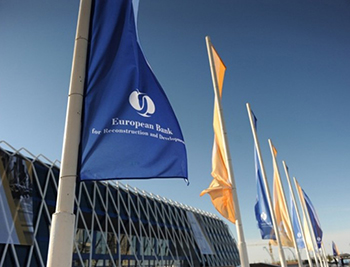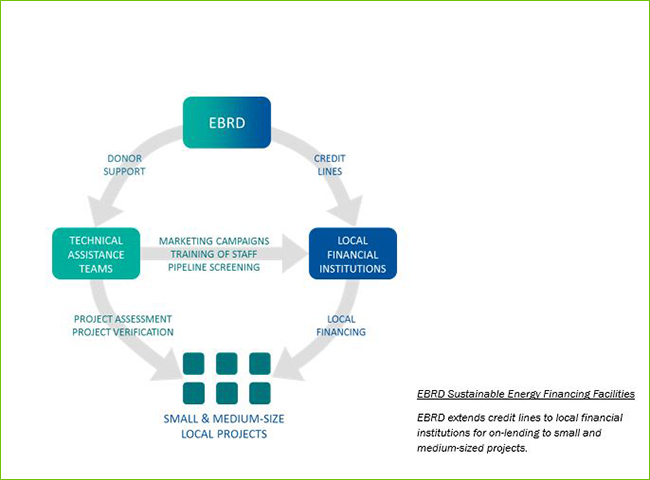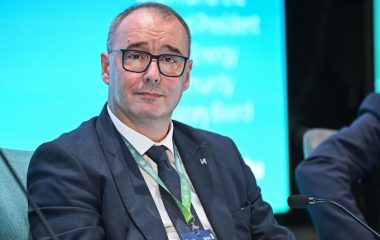
Photo: EBRD
By Ana Bachurova, EBRD Energy Efficiency and Climate Change team and Daniel Berg, EBRD Director for Serbia
The European Bank for Reconstruction and Development (EBRD) was the first international financial institution whose charter was explicitly “green” – that is, environmentally friendly. In Serbia, the EBRD investments in green projects account for more than EUR 800 million.
The Agreement Establishing the EBRD, signed in 1990, includes in the Bank’s mission the requirement “to promote… environmentally sound and sustainable development”. From its first days, the Bank has been working to put this concept into practice, following the relevant international processes and developing its internal capacity, policies and objectives.
Green projects help mitigate climate change by reducing greenhouse gas emissions, addressing adaptation to climate change, or delivering environmental benefits (resource efficiency, reduced pollution, and so on). In 2016, the Bank explicitly recognized the green dimension as an integral quality of successful, sustainable market economies.

A year earlier, in September 2015, the EBRD had approved its Green Economy Transition (GET) approach – a strategy that puts green investments at the heart of the Bank’s mandate, and sets an ambitious target for green financing (40 per cent of the EBRD’s total business volume by 2020). This will mean achieving EUR 18 billion of GET investments from 2016 to 2020, compared to cumulative green financing from 2006 to 2016 of EUR 22 billion.
In 2016, 33 per cent of the Bank’s investments were green projects. We are pleased that Serbia did very well: green investments accounted for 39 per cent of the EBRD’s total business volume during 2016. Highlights in Serbia include: the Belgrade bus renewal programme, upgrades to Belgrade’s water infrastructure, numerous projects with power utility EPS, the Schwarz Group retail expansion, and credit lines to local banks for energy efficiency improvements (known as the Western Balkans Sustainable Energy Financing Facility). Our advisory services to small and medium-sized enterprises (SMEs), supported by donor funding, also provide green advice, especially on energy efficiency.
An illustration of the resulting impact: the GET projects in Serbia have led to a reduction in CO2-equivalent emissions of 1,400 kt per year. This is approximately equivalent to removing 300,000 passenger vehicles from the country’s roads annually.
Traditionally, most green business in Serbia (and across the Western Balkans) has been achieved through projects with state and municipal companies and through special-purpose credit lines. Given the importance of the public sector in demonstrating the benefits of environmental investments, we continuously build on cooperation with national and municipal leaders to identify opportunities for applying the EBRD’s business model. EBRD is not just about financing, but also technical assistance and policy dialogue. One example is the Green Cities Framework, designed to help cities modernise their transport and public utilities.

Local banks have been the key to delivering loans to SMEs and households for renewable energy and energy efficiency. Since 2009, we have provided EUR 65 million to four commercial banks in Serbia for on-lending. In 2017, we are working with the European Union to set up a new credit line facility dedicated to energy efficiency in the residential sector.
We look forward to more private sector demand, especially as the private sector must be the driver of economic growth and therefore has a major impact on resource efficiency and pollution reduction. When firms incorporate environmental considerations into their decision-making (for example, as an opportunity to cut costs, or as a risk-management tool), they gain competitive advantage. Schwarz Group’s market expansion in Serbia is a good example of how environmental management and resource efficiency are well integrated. Our loan proceeds are used to finance cascade cooling and refrigeration with heat recovery and LED lighting, as a result of which the stores will consume 45% less energy compared to standards for new retail buildings. Their logistics centre is designed at the highest LEED level. This project also encourages Schwartz to work to improve standards of sustainability of its local suppliers.
Delivering green investments: the business model
The EBRD’s business model for supporting green investment is based on three pillars: appropriate financing, targeted technical assistance and policy dialogue.
We work with clients to identify appropriate financing, based on objective criteria – such as the size of the loan – and on case-specific features of the project. In addition to direct financing, we may be able to mobilise grants (for example, to support a project for the transfer of climate technology) or we may blend EBRD loans with concessional finance to help overcome clients’ perceptions of affordability and risk.
We provide technical assistance to corporate and utility clients, mainly during project preparation but also throughout implementation. Our resource efficiency audit is a popular tool that helps clients identify and prioritise measures for optimising the use of energy, water and materials and for cutting the cost of resources. We have a strong in-house team leading these audits and we also work with external experts.
Policy dialogue activities contribute to strengthening the institutional and regulatory environment and improve conditions for green investments. In Serbia, the EBRD has been mainly involved in policy dialogue in the renewable energy and energy efficiency sectors. There, the Bank works with the authorities to establish regulations that encourage private developers to build renewable energy projects. We also work to support the drafting of legislation that would allow energy service companies (ESCOs) to operate and innovate, and to assist in transposition of the EU’s Energy Efficiency Directive and the Energy Performance of Buildings Directive.
Cooperating with EPS
The EBRD began working with Serbia’s power utility EPS in 2001, initially to stabilise and repair the power network after years of underinvestment and lack of maintenance. Later we signed a loan to fund the purchase of smart meters that will improve energy efficiency in distribution while at the same time reducing power losses, including commercial losses from unpaid and stolen electricity. Together with the German Development Bank, KfW, we funded a project in 2011 to help EPS reduce emissions and improve the efficiency of the Obrenovac thermal power plant through quality-management systems.
Increasing the use of renewable energy is a key goal of Serbia’s energy strategy and an important goal for the EBRD. In 2011, we financed a project for the refurbishment and capacity expansion of a number of small hydropower plants, and to construct small hydropower units on existing water-management dams.
As part of the efforts to commercialize EPS, in 2015 the EBRD helped to restructure the company’s debt. Together with the IMF and World Bank we agreed on a comprehensive programme of reforms to improve operational and energy efficiency as well as governance and transparency. EPS is also working to control costs and reduce losses through increased bill collection and tariff adjustments.
Meanwhile, the EBRD is working to make EPS more accountable to Serbian citizens. An action plan has been agreed that reinforces the firm’s environmental and social policies, including its engagement with local communities. In March this year, EPS and the Serbian Environmental Protection Agency signed a cooperation agreement on environmental quality monitoring and reporting.
The Green Cities Programme
The EBRD’s Green Cities Framework is yet another example of how we make our investments greener. The Framework is designed to support cities in addressing systematically environmental challenges (air quality, water treatment, municipal waste, and so on). A key component is the Green City Action Plan (GCAP), a document that articulates a vision of sustainable development and strategic objectives, as well as priorities for reform and investment. GCAPs help us target investments that are most environmentally effective and provide appropriate policy guidance.
We are currently working with the City of Belgrade to begin a GCAP by the end of 2017, and we expect that other Serbian cities will follow.
Climate adaptation
A changing climate, including extreme weather events, highlights the need for businesses, utilities, and public institutions to be prepared and to make their operations resilient. The EBRD is integrating climate risk assessments and resilience measures in its investments. Since 2006, the Bank has provided more than €1 billion to 163 adaptation projects across our countries of operations. Alongside financing, the EBRD offers technical expertise to support clients in identifying how climate change may impact their operations, developing strategies to facilitate adaptation, integrating resilience in their investment plans, and training staff to mitigate risks.

The EBRD is currently analysing climate risks in road transport in the Western Balkans, including in Serbia. Through this assignment the EBRD will support efforts to improve infrastructure by identifying risks facing the network and potential measures to reduce these risks. Furthermore, in future investments, the EBRD aims to help introduce international best practices for climate resilience in road networks (for example, practices recommended by the World Road Association, Norway and Sweden).
The EBRD is also assessing the climate resilience of the power sector in Serbia, to understand better how changes in the availability of water will affect power generation and the reliability of supply.
Looking forward
The Bank will continue to make its operations increasingly green, both by scaling up its existing activities and being innovative in its business approach. Together with partners from Government, private sector, international organisations, and other stakeholders, we will continue to realise Serbia’s potential for mitigation, adaptation and in general environmental initiatives. This will change for the better not only the daily lives of the Serbian people but also the Serbian economy as a whole.


















Be the first one to comment on this article.